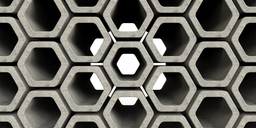Optimizable Hybrid Membrane/Catalyst Reactor Design using Dual-Layer Phase-Inversion Additive Manufacturing
TECHNOLOGY NUMBER: 2022-158

OVERVIEW
Hollow fiber membrane reactor for catalytic oxidative couple of methane (OCM)- Dual layer design provides for high selectivity and improved conversion rates
- Provides excellent interfacial layer adhesion and mechanical strength
BACKGROUND
Established routes to convert methane to ethane rely on indirect, energy-intensive steam reforming, which necessitates production at large scale. In comparison, direct methane conversion processes, such as oxidative coupling of methane (OCM) offer potential for greater energy and carbon atom efficiency, and are better suited for placement at smaller, more remote methane sources. Unfortunately, OCM systems to date have suffered from poor ethane selectivity, largely due to a mismatch between the rate of oxygen transport and the rate of catalyst activation, which results in over-oxidation side reactions that form unwanted CO and CO2.
INNOVATION
Researchers at the University of Michigan have developed a hollow fiber membrane reactor that utilizes an asymmetric dual-layer fiber to provide better control over oxygen flux and catalyst activation. The result is an OCM reactor capable of 30% methane conversion at 65% ethane (and higher hydrocarbons) selectivity. The membranes are made using an additive manufacturing process employing a continuous, simultaneous phase inversion approach. The process provides excellent control over catalyst layer thickness, which allows the number of active catalytic sites and by extension the rate of methane activation within the membrane to be tuned to match the flux of oxygen. Additionally, the manufacturing process is also simplified as compared to prior processes, requiring only a single sintering step. The hollow fiber geometry results in high volumetric reaction rates (greater than 0.2 mL of product forming per minute per square centimeter of membrane) and lower overall reactor volumes. The membranes display excellent interfacial layer adhesion and mechanical strength. The small diameter of the hollow fibers provides for enhanced heat transfer and improved heat management.